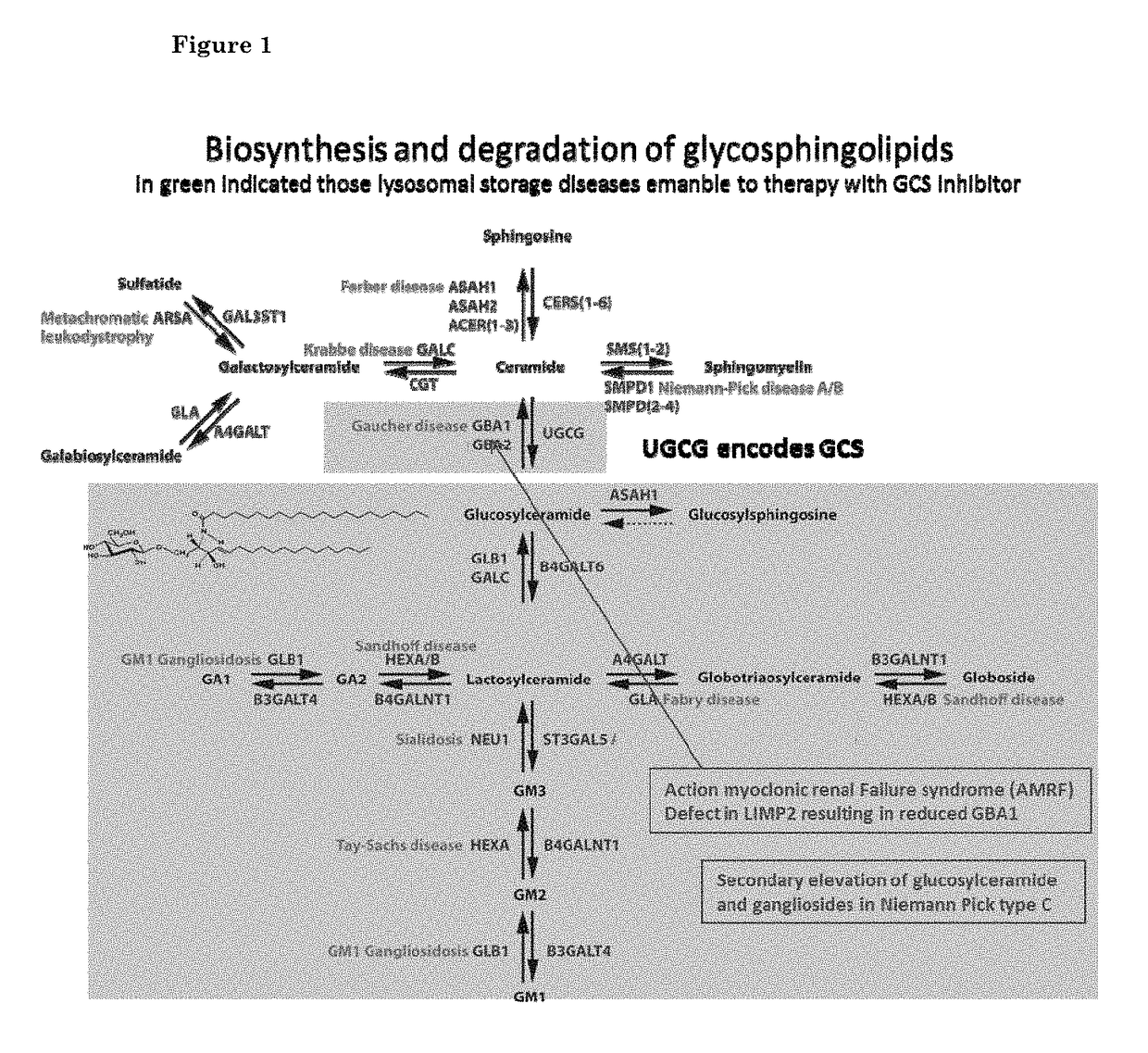N-(5-((aryl or heteroaryl)methyloxy)pentyl)-substituted iminosugars as inhibitors of glucosylceramide synthase
a technology of glucosylceramide and substituted iminosugars, which is applied in the direction of drug compositions, metabolic disorders, organic chemistry, etc., can solve the problems of severe physical discomfort, and increased glucosylceramide and/or other glycosphingolipid levels
- Summary
- Abstract
- Description
- Claims
- Application Information
AI Technical Summary
Benefits of technology
Problems solved by technology
Method used
Image
Examples
example 1
Preparation of Compounds of the Present Invention
[0420]In ROUTE A, the key step is the direct alkylation of the unprotected iminosugar IX or XI to the functionalized alkyl substituent under alkaline conditions.
[0421]The reactions which involved Suzuki cross-coupling chemistry were carried out under an argon atmosphere. The (stock) solutions were degassed for 1 h using an ultrasound bath and a stream of argon. A stock solution of the Z-substituted compound XIII or XIV (1.2 M) in ethanol, a stock solution of the boronic acid XV or XVI (1.5 M) in ethanol and a stock solution of Pd(PPh3)4 (5%) ethanol were made. To a reaction vessel were successively added NaOMe (0.180 gram, 3.3 mmol as a solid the final volume is 0.417+0.5+0.4+=1.1317 ml=2.5 M concentration), Z-substituted compound XIII or XIV (1.2 M, 0.417 mL, 0.5 mmol), boronic acid XV or XVI (1.5 M, 0.500 mL, 0.75 mmol) and Pd(PPh3)4 (2 mol %, 0.40 mL). The reaction mixture was stirred at 65° C. for 8-18 h, after which HPLC analysis...
example 2
Determination of the Inhibitory Potency
[0436]GCS. IC50 values for GCS activity were measured using living cells (macrophage RAW-267 cells grown to confluence in RPMI-1640+10% foetal calf serum (BSA) in a 5% CO2 incubator). Cells were washed with RPMI medium without serum (3×5 ml) and next exposed to 3 ml RPMI+0.3 mM conduritol B-epoxide, tested inhibitor and 5 nmol 6-[N-Methyl-N-(7-nitrobenz-2-oxa-1,3 diazol-4-yl)aminododecanoyl]sphingosyl-β-d-glucoside (C6-NBD-glucosylceramide) complex with BSA, successively. The cells were incubated for one hour at 37° Celsius and washed with medium without serum (5×5 ml). A 50 mM potassium phosphate buffer, pH 5.8, 0.75 ml) was added and the flask placed on ice. Cells were removed by scraping and the harvested cells collected in a vial that was immediately immersed in liquid nitrogen. The frozen cell lysate was suspended in 3 ml methanol and extracted with chloroform (3 ml). After extraction a 0.73% NaCl solution (2 ml) was added. After phase sep...
example 3
Inhibitory Potency of Deoxynojirimycin Derivatives of the D-Gluco Configuration Towards GCS, GBA1 and GBA2
[0441]
compoundGCSGBA2GBA1numberstructure[nM][nM][nM] 12002100 3400.71000 450210.000 540110.000 6250.08250 7250.08200 8250.12200 9250.0810010152125001120025001220031500137523001450312501575053000161504200017200103000182000102000192510300020251030002125102500222015800232010800242525002574260026252250272514002815056002950270030150335031500.760032150202500332510250034250.570351002250361003250
PUM
 Login to View More
Login to View More Abstract
Description
Claims
Application Information
 Login to View More
Login to View More - R&D
- Intellectual Property
- Life Sciences
- Materials
- Tech Scout
- Unparalleled Data Quality
- Higher Quality Content
- 60% Fewer Hallucinations
Browse by: Latest US Patents, China's latest patents, Technical Efficacy Thesaurus, Application Domain, Technology Topic, Popular Technical Reports.
© 2025 PatSnap. All rights reserved.Legal|Privacy policy|Modern Slavery Act Transparency Statement|Sitemap|About US| Contact US: help@patsnap.com



